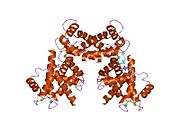S100A12
Ensembl |
| ||||||||
|---|---|---|---|---|---|---|---|---|---|
| UniProt |
| ||||||||
| RefSeq (mRNA) |
| ||||||||
| RefSeq (protein) |
| ||||||||
| Location (UCSC) | Chr 1: 153.37 – 153.38 Mb | n/a | |||||||
| PubMed search | [2] | n/a | |||||||
| View/Edit Human | |||
S100 calcium-binding protein A12 (S100A12) is a protein that in humans is encoded by the S100A12 gene.[3][4] Human S100A12, also known as calgranulin C, was first described in 1995.[5]
The protein encoded by this gene is a member of the S100 family of proteins containing 2
EF-hand
calcium-binding motifs.
Function
Generally, S100A12 has a significant anti-infectious and
antibacterial role that is related to its ability to uptake ions. For example, it inhibits the spread and virulence of H. pylori.[6][7]
Tissue distribution
hexamer.[10]
Clinical significance
Its presence is associated with
adhesion molecules such as ICAMs, VCAM or selectins is increased.[10] This protein is proposed to be involved in specific calcium-dependent signal transduction pathways and its regulatory effect on cytoskeletal components may modulate various neutrophil activities.[4]
Cascades that are triggered by interaction of S100A12 with RAGE may play an important role in
SLE patients as a marker of kidney damage in glomerulonephritis.[11][12] It is also associated with gastrointestinal diseases. In inflammatory bowel diseases, it significantly correlates with disease activity and, together with other 100S family proteins, can predict disease relapse.[13][14]
References
- ^ a b c GRCh38: Ensembl release 89: ENSG00000163221 – Ensembl, May 2017
- ^ "Human PubMed Reference:". National Center for Biotechnology Information, U.S. National Library of Medicine.
- PMID 8985590.
- ^ a b "Entrez Gene: S100A12 S100 calcium binding protein A12".
- PMID 8985590.
- PMID 17208591.
- S2CID 25627754.
- PMID 25854354.
- S2CID 21403491.[permanent dead link]
- ^ S2CID 25458683.
- PMID 23324110.
- S2CID 4256425.
- PMID 12740341.
- S2CID 10059250.
Further reading
- Roth J, Vogl T, Sorg C, Sunderkötter C (April 2003). "Phagocyte-specific S100 proteins: a novel group of proinflammatory molecules". Trends in Immunology. 24 (4): 155–8. PMID 12697438.
- Guignard F, Mauel J, Markert M (July 1995). "Identification and characterization of a novel human neutrophil protein related to the S100 family". The Biochemical Journal. 309 ( Pt 2) (2): 395–401. PMID 7626002.
- Schäfer BW, Wicki R, Engelkamp D, Mattei MG, Heizmann CW (February 1995). "Isolation of a YAC clone covering a cluster of nine S100 genes on human chromosome 1q21: rationale for a new nomenclature of the S100 calcium-binding protein family". Genomics. 25 (3): 638–43. PMID 7759097.
- Yamamura T, Hitomi J, Nagasaki K, Suzuki M, Takahashi E, Saito S, et al. (April 1996). "Human CAAF1 gene--molecular cloning, gene structure, and chromosome mapping". Biochemical and Biophysical Research Communications. 221 (2): 356–60. PMID 8619860.
- Marti T, Erttmann KD, Gallin MY (April 1996). "Host-parasite interaction in human onchocerciasis: identification and sequence analysis of a novel human calgranulin". Biochemical and Biophysical Research Communications. 221 (2): 454–8. PMID 8619876.
- Ilg EC, Troxler H, Bürgisser DM, Kuster T, Markert M, Guignard F, et al. (August 1996). "Amino acid sequence determination of human S100A12 (P6, calgranulin C, CGRP, CAAF1) by tandem mass spectrometry". Biochemical and Biophysical Research Communications. 225 (1): 146–50. PMID 8769108.
- Hofmann MA, Drury S, Fu C, Qu W, Taguchi A, Lu Y, et al. (June 1999). "RAGE mediates a novel proinflammatory axis: a central cell surface receptor for S100/calgranulin polypeptides". Cell. 97 (7): 889–901. S2CID 7208198.
- Moroz OV, Antson AA, Dodson GG, Wilson KS, Skibshoj I, Lukanidin EM, Bronstein IB (February 2000). "Crystallization and preliminary X-ray diffraction analysis of human calcium-binding protein S100A12". Acta Crystallographica. Section D, Biological Crystallography. 56 (Pt 2): 189–91. PMID 10666601.
- Moroz OV, Antson AA, Murshudov GN, Maitland NJ, Dodson GG, Wilson KS, et al. (January 2001). "The three-dimensional structure of human S100A12". Acta Crystallographica. Section D, Biological Crystallography. 57 (Pt 1): 20–9. PMID 11134923.
- Cole AM, Kim YH, Tahk S, Hong T, Weis P, Waring AJ, Ganz T (August 2001). "Calcitermin, a novel antimicrobial peptide isolated from human airway secretions". FEBS Letters. 504 (1–2): 5–10. S2CID 30480421.
- Moroz OV, Antson AA, Dodson EJ, Burrell HJ, Grist SJ, Lloyd RM, et al. (March 2002). "The structure of S100A12 in a hexameric form and its proposed role in receptor signalling". Acta Crystallographica. Section D, Biological Crystallography. 58 (Pt 3): 407–13. PMID 11856825.
- Strauss GI, Edvinsson L, Larsen FS, Møller K, Knudsen GM (2002). "Circulating levels of neuropeptides (CGRP, VIP, NPY) in patients with fulminant hepatic failure". Neuropeptides. 35 (3–4): 174–80. S2CID 23809011.
- Maayan C, Becker Y, Gesundheit B, Girgis SI (2002). "Calcitonin gene related peptide in familial dysautonomia". Neuropeptides. 35 (3–4): 189–95. S2CID 37251158.
- Filipek A, Jastrzebska B, Nowotny M, Kuznicki J (August 2002). "CacyBP/SIP, a calcyclin and Siah-1-interacting protein, binds EF-hand proteins of the S100 family". The Journal of Biological Chemistry. 277 (32): 28848–52. PMID 12042313.
- Ryckman C, Robichaud GA, Roy J, Cantin R, Tremblay MJ, Tessier PA (September 2002). "HIV-1 transcription and virus production are both accentuated by the proinflammatory myeloid-related proteins in human CD4+ T lymphocytes". Journal of Immunology. 169 (6): 3307–13. PMID 12218151.
- Foell D, Ichida F, Vogl T, Yu X, Chen R, Miyawaki T, et al. (April 2003). "S100A12 (EN-RAGE) in monitoring Kawasaki disease". Lancet. 361 (9365): 1270–2. S2CID 617800.
- Foell D, Kucharzik T, Kraft M, Vogl T, Sorg C, Domschke W, Roth J (June 2003). "Neutrophil derived human S100A12 (EN-RAGE) is strongly expressed during chronic active inflammatory bowel disease". Gut. 52 (6): 847–53. PMID 12740341.



